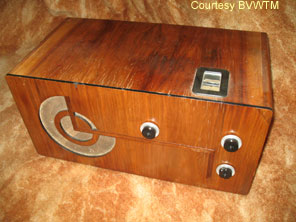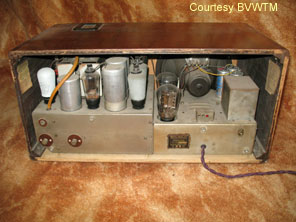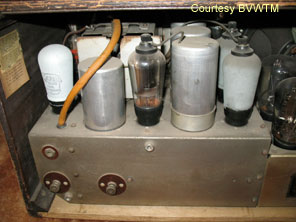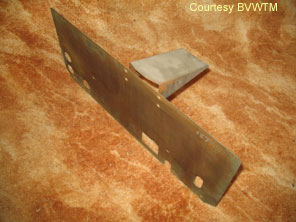|












| |

Murphy Radio Model
A8 From 1932  
Shown left is the Murphy A8. This was a jump for Murphy into the quality end of the radio market, until this receiver was offered Murphy had manufactured TRF radios with four valves. The Murphy A8 has no less that nine valves including rectifier. This is a very significant receiver in the history of radio in the U.K. for two principle reasons. Firstly, from an aesthetic point of view this was the first radio offered in landscape format (as opposed to upright or “tombstone”). It was also the first U.K. receiver to features AVC (Automatic Volume Control). This was an improvement that aimed to ensure that the output volume of the receiver remained as constant as possible irrespective of the strength of the signal from the transmitter.
The chassis is formed of two linked sub-chassis’s. The RF chassis carries seven valves to the left
(left below) whilst the power and output chassis carries the rectifier together with associated power components and also the output valve and loudspeaker. The output stage is formed of an AC/PEN output valve, which can deliver just over 3w. Having assembled such a first rate RF chassis it would perhaps have been worth finishing the radio off with a push-pull output stage, though this would have required at least two extra valves of course.
Perhaps Murphy were experimenting with materials for back panels during their early years of production, having utilised wood, card, hardboard and indeed nothing for some of their receivers until this point, for the Murphy A8 they chose pressed sheet steel. This was the first and last time Murphy used a
steel back in this form, and to aid heat dissipation a chimney is included to direct heat away from the output and rectifier valves and hence reduce the chances of heat damage to the cabinet in that area
(right below). It may be that supporting the chimney was the reason why metal was chosen for the back, though of course EMI managed to construct heat chimneys quite successfully for their receivers using card backs.
The cabinet is constructed from veneered plywood, and features a strongly geometric pattern to the front. Due to the relatively high valve count there are two 4v heater secondary windings from the mains transformer, which may also have assisted in receiver stability. Valve line up is VMS4, AC/S1VM, AC/HL, AC/S1VM, AC/S1VM, AC/DD, VMS4, AC/PEN, 1807. The AC/S1VM had only a short production life, and was replaced by the more commonly seen and available AC/SGVM.  
Continue to Murphy
1932 Model Range
© COPYRIGHT RETAINED ON ALL TEXT AND IMAGES ON
THIS SITE.
|







